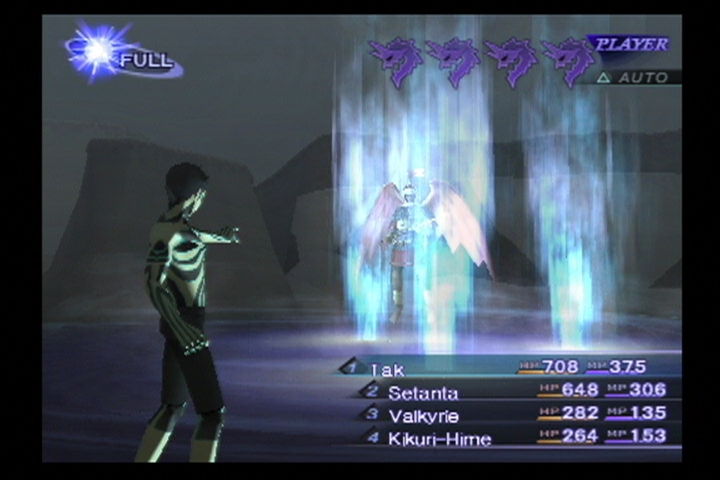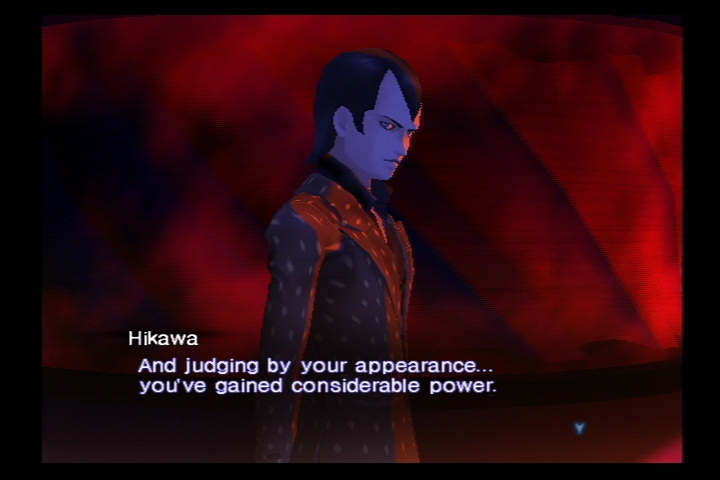|
|

|
PLATFORM
|
PS2
|
BATTLE SYSTEM
|

|
INTERACTION
|

|
ORIGINALITY
|

|
STORY
|

|
MUSIC & SOUND
|

|
VISUALS
|

|
CHALLENGE
|
Hard
|
COMPLETION TIME
|
60-80 Hours
|
|
OVERALL

|
+ Fun battle system allows players to capture demons and use them to fight with
+ Customization for learning skills from equipped demons gives gamers tremendous powers
+ Various choices are made by answering questions, offering up multiple endings and replay
- Difficulty in the game becomes a challenge for leveling and acquiring macca
- No voice overs in the game
- New game plus mode makes players start over from the beginning and the demon compilation is usable if the gamer has enough macca to purchase the higher level monsters
|
Click here for scoring definitions
|
|
|
Many RPG series exist where the thrill of the adventure is enthralling because of the characters that help guide the story. For some, though, the conventional norm of making a series thrive through religious, philosophical, and demonology becomes the staple of redefining the genre. Shin Megami Tensei III: Nocturne is the first official release of the Shin Megami Tensei franchise in the US, aside from the other spinoffs, that educates RPG veterans of demonstrating the dark themes of the world's destruction and rebirth. While many series use the domination and resurrection motif constantly, Shin Megami Tensei transforms the notion through the use of demons. Shin Megami Tensei III: Nocturne flaunts its controversial monsters through the interweaving of various mythologies and the concept of becoming a god.
The story centers on a young high school student in Tokyo, Japan. He becomes involved in the conception, which ultimately changes the world into a place where demons inhabit and usurption of power ensues through several groups of individuals that want to shape the world to their own accord. The paths to choose from are neutral, lawful, and chaos. The balance of order in the cosmos is introduced through the offerings of ayoung child and an older gentleman. But the player begins to hear propositions from others during the conception of the world that present the gamer with a choice. Characters such as Isamu Nitta, Jyoji Hijiri, Chiaki Hayasaka, and Yuko Takao all play a role in convincing the newly demon born protagonist in choosing a side that suits their own agenda. Even the young child's presentation of giving the main character demonic powers, in order to survive the conception, and the persuations of the old man offers both another path to choose from and discovering the truth. The game's originality of proposing choices for the player to make that changes the story around the main character is a superb technique in capitalizing on the free roaming aspect that many games incorporate today. Frequent themes of philosophy and demons that represent deities from mythologies not only adds to the story's uniqueness, but contributes to a new concept of presenting knowledgeable material in the form of entertainment. To provide a new outlook to the cliche of death and rebirth, by undertaking as an emissary of a god's will, is an enlightening and exiciting experience. Whatever path the player treads upon, however, the other characters turn against him. The journey to manifesting one's desires into fruition, and challenging a godlike entity, challenges the player to make it to the end in order to convert one's hope into a realistic future.
 "Witness divine devastation!"
"Witness divine devastation!"
|
|
Battling to the top of the tower in order to face a god is hard work that requires help. The battle system incorporates the protagonist to use his magatama power by recruiting demons in a turn based fight. But asking a monster to join is not an easy task. The demon will ask the player a question. Thusly, the main character must answer the right question based on the demon's alignment. If the demon is chaotic, then the creature will ask questions that pertain more to breaking the rules and fending for him or herself. The same applies for the other types as well. The questions become entertaining after awhile, but some demons that appear randomly on a certain moon phase can frustrate gamers in having a slim chance in acquring the beast. The protagonist has to be a the same level or higher in order to have the best opportunity of talking with and obtaining the creature. The ability to use some of the demons that the gamer does have helps in acquiring others because some monsters will not converse with the protagonist unless he meets a certain requirement. Once the demon is acquired, the creature will be added to the player's compilation list and can evolve later by leveling. The challenge of having a demon appear at a certain moment is time consuming and critical in order to power up the player's team. Unfortunately, training and acquring money, a.k.a macca, in the game is difficult and can aggravate others. The challenge in pursuing the Kalpas, a descending dungeon that becomes available after an event, serves as a challenge that tests a gamer's skill in becoming stronger. The mechanics of the battle system is enjoyable for RPG gamers that love the traditional turn style battles that are not in real time.
The RPG's visuals are intriguing as the characters are drawn in a style the embellishes the dark overtones that the game's setting presents. But some of the facial expressions that the characters express are hampered because of the lack of voice overs. The game will display pivotal scenes where the story is changing and the NPCs are moving their mouths, but nothing is coming out. Since the length of the game is long hard 60-80 hour endeavor, many gamers would like to see some more emotion from the mute non-player characters beside reading the text the entire time. The interaction between the game's visual style and playing experience mesh together as the violence and demonic powers fill the screen with tenacious fury. No voice overs will cause some gamers to not want to invest their emotions and interact with the character they chose to align with. But many RPG veterans of the past have adjusted to the lack of voice work for years, which exemplifies on the alluring quality that makes the game shine, appealing to gamers that want to play something different. The polygonal and three-dimensional characters and demons, that flaunt their power, intensifies the scenes with dramatic luster.
 "Choose or die!"
"Choose or die!"
|
|
The music and sound is phenomenal. The electric guitar and usage of techno coincides with the story and events. The dark atmosphere, which the demons evoke, plays out perfectly not only in battle, but dungeons as well. The electric guitar serves as the main instrument, and delivers a sound that fits the journey. The piano highlights the softer and more sad scenes where devastation occurs and the protagonist has no choice, except to move forward. The game comes with a soundtrack, and it is one of the best musical scores ever composed for an RPG franchise.
Shin Megami Tensei III: Nocturne is an experience that entices gamers to sample a new taste of RPG gameplay. While the spinoffs that follow after the main series have advanced on the complexity and difficulity of the franchise, gamers that wish to try their hand at the title that made the Shin Megami Tensei series a success in the US should play Nocturne. It is an adventure that raises some controversy over religion and philosophy, which may cause some to stay away. But the open minded individuals that undertake the mature themes in the game, become involved in a journey that shapes a new world.
Review Archives
|









